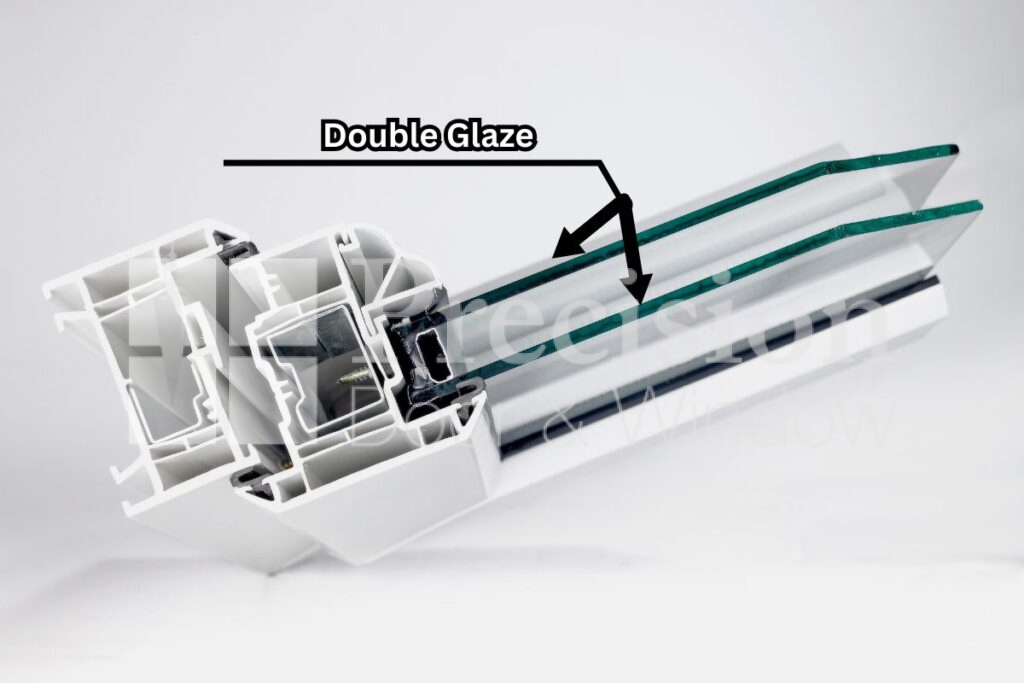Window glazing can sound like a complicated thing, but really, it’s just the amount and type of window panes within a window. It affects the window’s energy efficiency and provides you with the advantages you need in order to have a secure and comfortable home.
At Precision Door & Window, we understand that window glazing is a little-known thing and can create confusion. That’s why we’ve created this quick guide to explain the common types of window glazing.
Call us today at (951) 501-4479 for a no-obligation discussion with our professionals.
What Are The Different Types of Window Glazing?
Whether you’re building a new home or considering window replacement, understanding the various types of window glazing options can help you make an informed decision.
Here are the common types of window glazing options that you’ll find:
#1 Single Glaze

Single-glazed windows, perhaps the oldest type of window glazing, consist of a single pane of glass. Although these windows were once standard in residential construction, they’ve become less common because of their poor energy efficiency.
You might still find them in older homes or in regions with mild climates, but they’re generally not recommended for modern construction, particularly in areas with extreme temperatures.
#2 Double Glaze

Double-glazed windows, also known as dual-pane windows, have become the standard in modern window glazing.
These windows feature two panes of glass separated by a spacer and an air gap, much like the design you’ll find for casement windows.
This configuration significantly improves insulation against heat transfer and sound transmission, making them an excellent choice for residential properties.
#3 Clear Glass
Clear glass remains one of the most straightforward types of window glazing available. While it provides excellent visibility and natural light transmission, it provides lower energy efficiency when compared to other glazing types.
Clear glass is typically used for commercial window glazing applications where visibility is the primary concern.
#4 Low-E Glass Windows
Low-emissivity (Low-E) glazing is achieved with the help of an invisible metallic coating that allows natural light to enter while reflecting extra heat.
During winter, this glazing helps retain indoor heat, while in summer it reflects unwanted solar heat, making it an energy-efficient choice for various glazing materials.
#5 Heat Retention Windows
Similar to Low-E glass, heat retention window glazing focuses specifically on keeping warmth inside your home.
This type of glazing proves particularly beneficial in colder climates by reflecting interior heat back into your space, much like how certain casement windows are designed for optimal thermal performance.
#6 Tempered Glass Windows
When it comes to safety in window glazing, tempered glass can be a nice choice.
Through a special heating and cooling process, this glass becomes significantly stronger than standard glass, and when it breaks, it does so into small, rounded pieces rather than sharp shards, making it an excellent choice for areas where safety is a primary concern.
#7 Laminated Glass Windows
Laminated glass is made by bonding multiple glass layers with a special interlayer, which makes it another safety-focused option in window glazing.
Laminate glass is also popular because it does not shatter after any impact, which makes them a safe and secure choice for your property.
#8 Obscure Glass Windows
For spaces requiring privacy without sacrificing natural light, obscure glass provides an ideal solution.
This type of window glazing features textured patterns that blur visibility while maintaining light transmission. It’s particularly popular in bathroom windows and other areas where privacy is essential.
What Is the Difference Between Window Glazing and Glazing Compounds?
Many homeowners get confused between window glazing and glazing compounds, so we’re here to fill you in on the differences.
Glazing compounds are part of window glazing. Professionals use these compounds between the glass panes to create a durable seal and maintain the integrity of your windows’ glazing systems.
Commonly, there are two types of glazing compounds: oil-based and latex-based. Oil-based compounds provide excellent durability and water resistance, while latex-based options provide easier application and cleanup.
⭐BONUS
Here Are Some Special Window Glazing Options
#1 Smart Glazing
Smart glazing technology allows windows to change their tint electronically, providing dynamic control over light transmission and heat gain. This innovative approach to window glazing helps optimize energy efficiency while maintaining comfort throughout the day.
#2 Acoustic Glazing
For properties in noisy areas, acoustic glazing offers enhanced sound reduction capabilities. This specialized type of window glazing uses various glass thicknesses and special interlayers to minimize sound transmission, creating a quieter indoor environment.
By understanding these various types of window glazing, you can make an informed decision that best suits your specific needs and requirements. Whether you prioritize energy efficiency, security, or sound reduction, there’s a glazing solution available for your home.
Call Precision Door & Window For Professional Window Services In California
At Precision Door & Window, we are your local window professionals in California. Don’t worry if you are still confused about choosing the right type of window glazing for your home, our team is here to assist you in each step of your window installation process.
We take pride in providing personalized solutions that consider your specific climate conditions, energy efficiency goals, and aesthetic preferences.
Whether you’re interested in energy-efficient double glazing or need secure laminated glass for your windows, our team can help you make the best choice for your home.
Call us today at (951) 501-4479 to schedule a free consultation and learn more about how we can add more value to your home with the perfect window glazing solution.
FAQ’s
A: Low-E (low-emissivity) glass has a thin metallic coating that reflects heat while also allowing light to pass through, improving energy efficiency.
A: Consider reglazing if you notice drafts, condensation between panes, or increased energy bills, indicating compromised window performance.
A: Certain glazing types, like laminated or tempered glass, enhance security by making windows harder to break. This is particularly useful for homes in high-crime areas or hurricane-prone regions.

